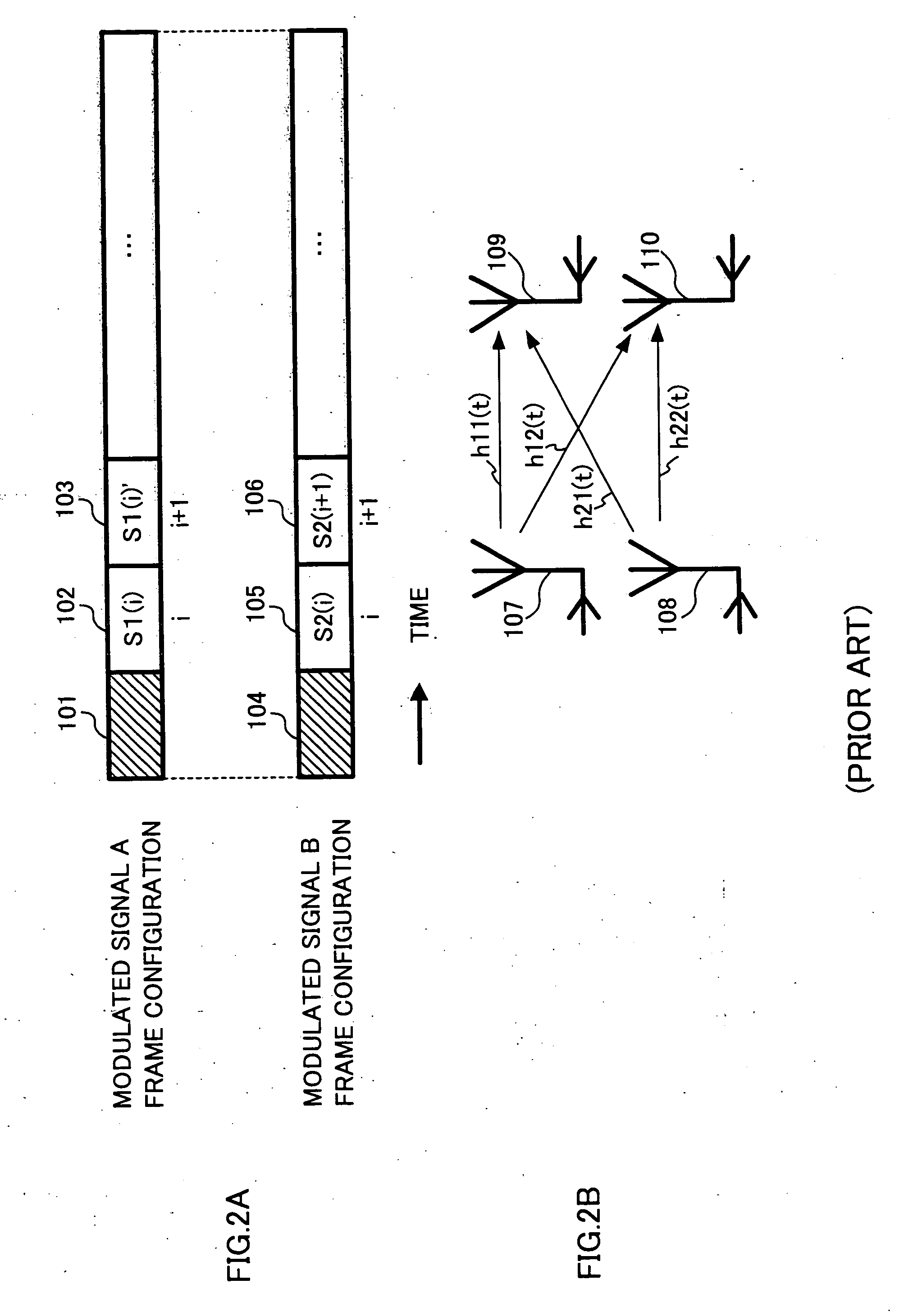Communication apparatus and communication method
a technology applied in the field of communication apparatus and communication method, can solve the problems of reducing transmission efficiency and effective data transmission speed, and achieve the effect of suppressing a decrease in data transmission efficiency, excellent reception quality, and improving reception quality
- Summary
- Abstract
- Description
- Claims
- Application Information
AI Technical Summary
Benefits of technology
Problems solved by technology
Method used
Image
Examples
embodiment 1
(1) EMBODIMENT 1
[0080] In this embodiment it is proposed that, when a first and second antenna are used and a different modulated signal is transmitted from each antenna, the same data be transmitted a plurality of times for only one modulated signal. In this embodiment, two modulated signals are formed by modulating two different streams of data, and these two modulated signals are transmitted from different antennas. At this time, in a modulated signal transmitted from one of the antennas, the same data is transmitted a plurality of times, changing the signal point arrangement mode. By this means, since different modulated signals are basically transmitted from each antenna, the error rate performances of data transmitted a plurality of times can be improved, and as a result, the error rate performances of both streams (the two streams) can be improved, while maintaining a higher data transmission speed than when space-time block coding is used.
[0081]FIG. 2A shows frame configura...
embodiment 2
(2) EMBODIMENT 2
[0220] In Embodiment 1, it was proposed that, in transmitting two different modulated signals using two antennas, the same data be transmitted a plurality of times for only one of the modulated signals. In contrast, in this embodiment it is proposed that, in transmitting three different modulated signals using three antennas, the same data be transmitted a plurality of times for one or two of the three modulated signals, and associated actual frame configurations and apparatus configurations are described.
[0221]FIG. 15, in which parts corresponding to those in FIG. 2A are assigned the same codes as in FIG. 2A, shows sample frame configurations of modulated signals according to this embodiment. In this embodiment, a modulated signal C is transmitted at the same time as modulated signal A and modulated signal B. Modulated signal C contains a radio wave propagation environment estimation symbol 1401. Reference codes 1402 and 1403 denote data symbols. Modulated signal C...
example 1
(2-1) VARIANT EXAMPLE 1
[0265] In this embodiment a case has been described in which the frame configurations transmitted by transmitting apparatus 1700 are as shown in FIG. 15, but the transmitted frame configurations may also be as shown in FIG. 16. The difference between the frame configurations in FIG. 16 and the frame configurations in FIG. 15 is that the time difference in transmitting signal S1(i) in which the same data is modulated in modulated signal A is made small in the case of FIG. 15, but is made very large in FIG. 16.
[0266] Consequently, the radio wave propagation environment is totally different at time i and time j. Considering this, in the case of FIG. 16, the signal point arrangement of modulated signal A transmitted at time j is made the same as the signal point arrangement of modulated signal A transmitted at time i. This is because it was considered that, even if the signal point arrangement of modulated signal A is not intentionally varied, the time i and time...
PUM
 Login to View More
Login to View More Abstract
Description
Claims
Application Information
 Login to View More
Login to View More - R&D
- Intellectual Property
- Life Sciences
- Materials
- Tech Scout
- Unparalleled Data Quality
- Higher Quality Content
- 60% Fewer Hallucinations
Browse by: Latest US Patents, China's latest patents, Technical Efficacy Thesaurus, Application Domain, Technology Topic, Popular Technical Reports.
© 2025 PatSnap. All rights reserved.Legal|Privacy policy|Modern Slavery Act Transparency Statement|Sitemap|About US| Contact US: help@patsnap.com



